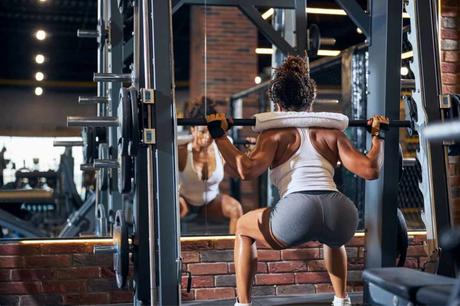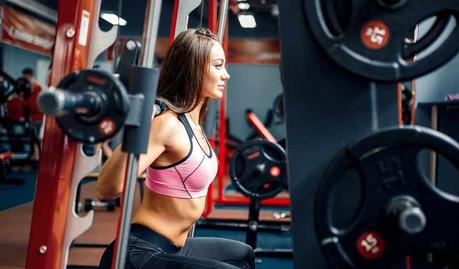The squat rack and Smith machine look similar, but vary widely in function and results. Here’s a detailed look at the differences between a squat rack and a Smith machine.

Squat racks are possibly the most used of the machines/racks/equipment in any gym.
No matter what time of day you go, there will always (and I do mean always!) be someone at the squat rack working on building leg power.
The Smith machine, on the other hand, doesn’t get quite as much love. It’s one of the least-used machines, pretty much available around the clock.
But why is that? Why do people gravitate more toward the squat rack and steer clear of the Smith machine?
In this post, we’re going to find out!
Below, I’ll explain the fundamental differences between these two machines, and show you why the squat rack is the more popular choice.
Plus, I’ll walk you through the benefits of using one over the other—and the truth will surprise you!
Let’s jump right in.
Squat Rack – The Basics
The squat rack is exactly what it sounds like: a rack used to support the weights (barbells) that you use for squatting.
Typically, it’s made like a four-vertical-bar cage with horizontal supports or cradles that hold the barbell elevated to just below your shoulder height.
When the time comes to squat, simply stand beneath the barbell, push up with your legs (NOT YOUR BACK!) to lift the weight off the rack, and get squatting.
Smith Machine – The Basics
A smith machine is a machine that features a barbell anchored along a sliding vertical or near-vertical (angled) track. The barbell typically has an attached “hook” that latches onto the supports or slots to support the weight.
When the time comes to squat, stand beneath the barbell, push up with your legs, unhook the support, and get squatting.
Squat Racks vs Smith Machines – The Differences
Both squat racks and smith machines are commonly used for squatting. However, though they’re utilized for the same exercises, they are actually fundamentally different in many ways.
Difference #1: Fixed vs. Free Trajectory
One of the reasons that a lot of people (myself included) prefer the squat rack is the freedom of movement.
With the squat rack, you only have to deal with the weight of a squat bar plus whatever weight plates/discs you’ve added on, but you are free to move through whatever squatting range of motion feels most natural.
With the smith machine, however, you have to move along a fixed trajectory. Because the barbell is affixed to the sliding rail, you can only slide directly up and down along the vertical or near-vertical angle.
This fixed trajectory doesn’t allow for joint insufficiencies, instabilities, or limited range of motion.
For people like me with lower back and knee problems, it’s difficult to find the exact right posture and foot placement that will compensate for my joint problems—ultimately, I end up with either an aching lower back or throbbing knees because my movement trajectory is constrained.
Difference #2: Secondary/Stabilizer Muscle Recruitment
With the Smith machine, you’re sliding the bar up and down along a fixed trajectory. Instead of having to fight to maintain your balance, you can simply lean forward/push back against the barbell, and the slide rail will keep it firmly in place.
What this means is that there is little to no effort invested into keeping your balance. The focus is entirely on your legs, but your secondary stabilizer muscles (like your lower back, obliques, abs, and hips) remain largely inactive.
This is not at all a good thing. You WANT your secondary stabilizer muscles to get involved in the exercises because that’s how you improve your balance and posture—not just when lifting weights, but in every type of movement and activity.
Because squat racks use (literally) “free” weights that don’t move on a fixed trajectory, your secondary stability muscles have to work much harder to keep you upright through the full range of motion.
Because of that, they improve your balance significantly.

Difference #3: Different Weight Capabilities
In this, as with the battle of leg press vs squats, Smith machines get the slight edge over squat racks.
Why is that? Let me explain…
When you work with free weights, you’re not just focused on pushing the weight directly up and down. As I explained above, your muscles (prime movers and secondary/stabilizers) have to work on lifting the weight and keeping your balance at the same time.
While this is better for your overall fitness and agility, it decreases the “focus” of the muscular force. Some of the muscular force is diverted from the primary squatting movement and used for the secondary purpose of maintaining balance/stability.
With machines like leg presses and smith machines that work along a fixed trajectory, however, there is no need for stabilization. The sliding rail keeps the weight moving only up and down with no wobble, bend, or waver.
Looking for a detailed look at the top squat racks on the market right now? Here is a breakdown of the best squat racks on the market for every kind of home or garage gym.
This means that there is no need for the secondary muscles to engage, so all of the force comes from the prime movers.
But that’s not the only thing helping you lift heavier! When you push against the smith bar, there really is only ONE way for it to move: up.
Even if you push backward or forward, it will slide the bar up the rails. This means that all of the force is channeled in a single direction (upward) no matter what angle you attack it from.
Difference #4: Greater Load Capacity
Smith machines are typically larger, sturdier machines designed to accommodate a lot of weight—not only the bar, but also the slide rails, supports, posts, etc.
They can easily support hundreds of pounds without shaking, tipping, or wobbling.
Squat racks, on the other hand, come in a variety of designs—from the heavy-duty racks found at your local gyms to compact racks better-suited to home gyms.
While the former is more than strong enough to handle just as much weight as a smith machine, the latter (for home use) may start to wobble or lose stability if you overload it (with more than 300-400 pounds, depending on weight capacity).
Difference #5: Space Requirements
Smith machines are big, heavy-duty machines that take up a lot of space. Commercial (gym) squat racks are nearly as large.
However, compact squat machines designed for at-home use will be much more compact and occupy far less room.
There are a ton of different types of squat racks, including half racks, squat stands, folding squat racks, as well as your full-size power racks to choose from.
You can fit a squat rack into your home gym along with other equipment, but you’ll need a lot more free space for a Smith machine—not ideal if you’re working in a small garage, basement, or backyard.
Difference #6: Spotting Needed
Many squat racks are designed with a “safety” that will catch the bar roughly 2-3 feet off the ground. That way, if you fall while squatting, the weight won’t hit the floor with you.
However, that’s pretty much the only safety/assist feature built into squat racks. If you’re struggling to get the weight back up to its cradle/support, you’re on your own, with no additional help. That means you likely need a spotter to help you on those last few reps to failure.
With a Smith machine, however, the slide rail features multiple built-in hooks/supports where you can set the bar if you’re struggling to complete a set.
See also: 6 Best J-Hooks for Squat Racks
You won’t need a spotter because the Smith machine is designed to “spot” for you and is ideal for lifters who want the added peace of mind that comes with a built-in spotter.
Difference #7: Additional Features
This isn’t the case with all Smith machines, but “hybrid” Smith machines feature additional equipment, like a built-in bench, cable pulley system, even a power rack.
These are definitely pricier than a Smith machine on its own, but it makes for a decent all-in-one home gym solution.
With a squat rack, you get the rack and nothing else, no fluff or add-ons. That’s not a problem if you’ve got a range of other equipment, but for anyone who is looking for versatility over single-purpose design, it may be less than ideal.
Squat Racks vs Smith Machine – FAQs
Can I use a Smith machine as a squat rack?
You absolutely can! The barbell will slide along a single fixed trajectory (as described above), so you may find squatting with the Smith machine can be a bit uncomfortable on your back or knees until you master the form/posture.
However, it’s as easy as racking the Smith machine bar up high, adding your weight, and squatting to your heart’s content!
Is the Smith machine better for hypertrophy?
This is one of the things a lot of gym-goers fail to understand about the smith machine. People aiming for hypertrophy and concentrated focus on just the prime movers should consider using the smith machine because of its design.
Removing the stabilizer muscles from the equation means maximum recruitment of your leg muscles, and you can hammer at your muscles until they hit failure.
That leads to much more concentrated growth of just your leg muscles—and if that’s your endgame, the smith machine is your best choice.
Why do Smith machines get so much hate?
Really, it’s because of the limitations in your trajectory. As I explained above, the smith machine forces you to move along a fixed trajectory, which doesn’t really accommodate stiff, tight, or immobile joints.
People with lower back, knee, hip, or ankle problems often dislike the smith machine because it doesn’t allow their bodies to adapt their posture/form to compensate for those musculoskeletal issues.
But that doesn’t mean the Smith machine is bad. Really, it’s just misunderstood. As you’ve seen above, there are a lot of things to love about the smith machine—even over the squat rack!
The Bottom Line
Let’s be honest: we all know that the squat rack is the star of the show, the hero of Leg Day, the piece of gym equipment we all gravitate towards because squats are “the best of the best”.
But that doesn’t mean it’s the only piece of equipment you should be working with. It’s critical that you incorporate other machines into your workout in order to adapt your training regimen for maximum results.
If your desired result is just overall mobility, balance, and agility, then sticking with free weights on the squat rack is the smart way to go.
But if you want to build serious muscle and concentrate the focus on just the prime movers with the end goal of max hypertrophy, then you’d do well to mix in some smith machine exercises, too!
More Stuff Like This
How to Do Squats Without a Squat Rack. No squat rack? No worries. Here are some effective barbell squat alternatives that you can do to conquer leg day.
9 Things to Know Before Buying a Squat Rack. There has never been a better time to invest in a squat rack for your home gym. Here’s the ultimate buyer’s guide for purchasing a squat rack.
